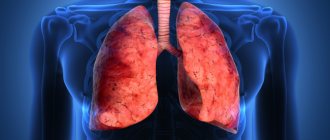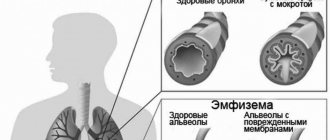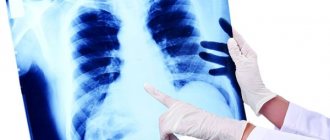Lung cancer: how to suspect the disease at an early stage
Lung cancer is one of the most aggressive cancers, usually detected at a late stage, progresses very quickly and is difficult to treat. The problem is that lung tissue lacks
nerve endings, so the patient does not feel pain during the primary growth of the tumor. Another feature of the lungs is the ability of the organ to perform its function when more than half the volume of lung tissue is affected. It is these features that help the body survive in difficult conditions that play a fatal role in patients with lung cancer.
Early stage of lung cancer
Stages of development of pulmonary oncology
There are stages of development of a pulmonary tumor:
- latent (biological). This is the period from the origin of the tumor to its appearance on x-rays.
- second stage (asymptomatic). You can recognize changes in tissue from an x-ray;
- third stage (clinical). Signs indicating the presence of a neoplasm appear.
Systematization by stages indicates that the insidiousness of lung cancer lies in the asymptomatic nature of the first two stages.
Sad statistics
In terms of prevalence, lung cancer ranks first among all other malignant diseases. Thus, every year one million people are diagnosed with this disease, 60% of whom die. In Russia, this pathology accounts for about 12% of the total number of cancer cases. Of all cancer deaths, 15% die from lung cancer.
In addition, the disease occurs three times more often among the male population than among the female population. Every fourth man with cancer suffers from this particular disease, while among women - only every twelfth.
Symptoms indicating the possibility of developing lung cancer
The first signs of lung cancer are often diagnosed as other diseases.
There is also a psychological factor at work here. A person is more inclined to believe that he has a complication from an infectious disease than to admit the idea of cancer. Therefore, they go to see therapists, ophthalmologists and other specialists. An experienced doctor, before making a diagnosis, recommends doing a biopsy or bronchoscopy at the first suspicion.
Early signs can be divided into
- to external ones. Those that can be identified visually;
- physiological. Changes in the state of the body as a whole.
Symptoms. External signs
Information about external signs makes it possible to independently determine them and undergo an examination.
How does lung cancer manifest?
- The ring phalanx of the fingers changes. The upper phalanx thickens and rounds, the nail resembles the shape of a watch glass (“drumsticks”);
- a lymph node appears in the supraclavicular cavity. Under normal conditions, it is neither visible nor palpable. Enlarged lymph nodes in the area around the chest are characteristic of the first symptoms of cancer;
- the color of the skin changes. Becomes pale with a yellowish tint;
Malignant cancer of the upper lobe of the lung may be accompanied by Horner's syndrome. The tumor compresses the cervical sympathetic nerve endings, which leads to the following consequences.
- The eyelid droops.
- The pupil narrows. Stops responding to light changes.
- The eyeball sinks.
Physiological changes in the body
Symptoms of lung cancer at an early stage are accompanied by the following changes:
- prolonged, worsening cough (more than two weeks);
- general fatigue. Fatigue does not go away after rest;
- loss of appetite, decreased vitality;
- a person loses weight;
- the body is susceptible to infections and bronchitis. This happens because immunity decreases.
The first symptoms in the early stages of lung cancer are similar to the clinical signs that appear in many inflammatory processes.
In order to recognize cancer, it is necessary to become familiar with the types of lung oncology.
Federal State Budgetary Institution "National Medical Research Center of Radiology" of the Ministry of Health of the Russian Federation
Version for the visually impaired
ENG
+7
Weekdays from 8:00 – 20:00 Make an appointment
home
Patient Information
The first signs and symptoms of lung cancer - timely diagnosis of the disease
Lung cancer is a malignant epithelial tumor. The forms of the disease differ in the spread of metastases, the tendency for the disease to recur at an early stage, and its general clinical diversity.
Most often, the first symptoms of lung cancer do not cause anxiety in patients; they are not distinctive. These include:
- irregular cough;
- fatigue;
- decreased appetite;
- a sharp decrease in body weight;
- at more advanced stages, a cough with blood streaks and shortness of breath “connects”;
- when metastases reach organs and tissues, pain is observed.
We can say that the presence of any defining signs of cancer is practically absent, that is, diagnosing the disease by tracking the first signs of lung cancer is almost impossible. This is justified by the fact that the lungs are completely devoid of nerve endings and the presence of 26% of healthy lung tissue is sufficient to provide the body with the required amount of oxygen. The growth of the tumor lasts more than one year - it is a long process that can last up to ten years.
There are several stages of lung cancer development:
- Biological stage - the time from tumor formation to the first signs on X-ray examinations.
- Asymptomatic stage - absence of symptoms, signs of cancer appear, which can be detected using x-rays.;
- Clinical stage - the first symptoms of lung cancer appear.
In the first two periods of the onset of the oncological process, the patient does not yet notice a deterioration in health. Treatment and preventive care is rarely sought at this stage, so timely diagnosis at an early stage is considered difficult.
The first signs of lung cancer are manifested by a simple decrease in the patient’s activity, rapid fatigue from ordinary household activities, loss of interest, a depressed state, decreased performance, and the appearance of weakness.
As cancer progresses, it often disguises itself as bronchitis, inflammation of the respiratory tract, viral infections, pneumonia, etc. There is a systematic increase in body temperature, restoration of the regime and again an increase to fever. Taking medications during treatment interrupts the symptoms of illness, but the process is repeated periodically over several months. These symptoms of lung cancer force patients who are at least a little worried about their health to seek advice from a doctor, but identifying a tumor at this stage is quite difficult.
The appearance of shortness of breath, pulmonary failure, problems with heart rhythm, chest pain indicate the presence of lung cancer, and already in the second or third stage. This is due to the extensive loss of entire lobes of the lungs from the respiratory process, which undoubtedly has consequences that affect the patient’s health.
As for the cough, at the early stage of the disease it is rare and dry and resembles coughing, without sputum (if the cancer is central). Further, the cough bothers the patient more and more and becomes hacking. When blood appears in the sputum, a person usually consults a doctor immediately.
Along with streaks of blood in the sputum, most patients experience chest pain, precisely on the side where the tumor is later discovered.
Another indication of the advanced state of the tumor is the difficulty of passing food through the esophagus, which resembles a masked inflammation of the esophagus. This is explained by the fact that the esophagus is constrained by metastases in the lymph nodes, which leads to disruption of the easy movement of food.
When metastases reach the intercostal nerves, for many the pain only intensifies. The intensity of the pain threshold also depends on how involved the thoracic subcostal membrane is in the process.
It is worth noting that often symptoms of lung cancer not directly related to this organ indicate the fourth stage of lung cancer, when metastases spread to neighboring organs or tissues, disrupting their normal functioning. This leads to the fact that patients turn to a cardiologist, therapist, ophthalmologist, orthopedist and other highly specialized specialists, unaware of the real cause of the ailment.
Peripheral lung cancer - main symptoms and first signs
This form of the disease progresses for a long time without symptoms, which significantly complicates the process of identifying the disease. The tumor grows into organs that are located nearby and rapidly increases in volume. The first signs of this type of lung cancer are periodic chest pain and shortness of breath. The more shortness of breath the patient has, the larger the size of the tumor in the body. It is worth noting that the majority of cancer patients experience shortness of breath, and in every tenth person it is one of the first symptoms.
Chest pain of a constant or transient type worries almost half of patients. Most often, chest pain is localized to the side where the tumor is located.
Small cell lung cancer - difficult to detect at an early stage
This form of cancer, which refers to histology, is characterized by early penetration of metastases into tissues and organs and is almost always malignant. Small cell lung cancer is rare and manifests itself through intoxication and shortness of breath.
USEFUL RESOURCES
Facebook Instagram YouTube
- Feedback
- Anti-corruption
- Controlling organizations
- Employee Login
© 2019 — Official website of the National Medical Research Center of Radiology of the Russian Ministry of Health. Privacy Policy
Website development
Classification of lung oncologies
In medicine, about two dozen types of lung cancer are classified. The tumor develops from lung tissue. The type of lung tissue cells that degenerate into malignant ones became the basis for identifying types:
- small cell lung cancer. The most dangerous and fastest growing species. It is characterized by rapid spread of metastases. This type is directly associated with smoking. Of the total number of patients, only one percent are non-smokers;
- Large cell carcinoma develops from epithelial cells. Like small cell, it is accompanied by active growth of metastases. Difficult to diagnose at an early stage. Its manifestation is usually recorded at the stage of tumor formation, on an x-ray. More often detected after 40 years and in older people;
- Carcinoma develops from the cells of the mucous and glandular tissue of the lung. As a rule, it is localized in one of the parts of the lungs. The most common type.
- Squamous cell carcinoma develops in bronchial squamous epithelial cells.
- mixed look. Different lung tissues are affected.
This is a somewhat simplified classification. Each species is divided into varieties.
Division by localization
For an accurate diagnosis and treatment, it is necessary to determine the location of the tumor.
How to identify lung cancer by location.
There are:
- apical. The tumor affects the upper lobe of the lung. It is this type of tumor that provokes Horner's syndrome and neurological manifestations (headaches, facial asymmetry, lymph nodes in the clavicle area);
- peripheral. Formed on the lateral surfaces of lung tissue. Since the tumor develops in the bronchioles and small blood vessels, obvious symptoms of cancer may not appear for a long time;
- central. The most acute form, as it affects the main part of the lung.
- atypical. Combined type of localization.
Diagnostic specialists also describe the form of the neoplasm (nodular, nodular-branched, etc.)
Third stage
Depending on how quickly lung cancer develops, this stage is divided into two stages:
Stage 3a. The tumor has a diameter of more than five centimeters. Damage to the pleura and chest wall is noted. Metastases reach the bronchial and lymph nodes. The prognosis is favorable in only 30% of patients. More than 50% of all lung cancer cases are diagnosed at this stage.
Stage 3b. As lung cancer progresses, the size of the tumor increases. The main feature of this stage is the involvement of the vascular system, esophagus, heart and spine in the process.
The prognosis is generally unfavorable.
It is impossible to answer how long it takes for lung cancer to develop at this stage. However, almost always at this stage, clear symptoms of the process appear. The patient may experience:
- painful, persistent cough with bloody or purulent sputum;
- constant pain in the chest area, which intensifies when inhaling;
- severe weight loss;
- complete loss of appetite;
- constant shortness of breath that occurs even with the slightest physical exertion;
- increased body temperature;
- regular bronchitis and pneumonia;
- when listening, wheezing appears in the lungs;
- pain in the shoulder girdle;
- numbness of fingertips;
- regular occurrence of dizziness and headaches;
- Vision and hearing may be impaired.
If cancer is detected at this stage, the patient’s chances of recovery are significantly reduced.
Stages of lung cancer and their manifestations
If in the early stages the symptoms are similar to other diseases. Then in the later stages, clear signs appear that indicate lung cancer.
Therefore, there are 4 stages:
- small localized tumor (up to 4 cm). Determined by fluorography or other hardware forms of examination;
- penetration of the tumor into the lymph nodes and growth of the tumor;
- the tumor spreads beyond the chest;
- metastasis affects most of the body, with localization in different places.
Signs of stages 3 and 4
The manifestation of signs of late stages is accompanied by:
- increasing pain in different parts of the body, depending on the location and area affected by metastases;
- during this period shortness of breath and characteristic noises in the lungs appear;
- worsening cough, accompanied by sputum with blood;
- As the size of the tumor increases, the larynx and esophagus are compressed. There are difficulties when swallowing food;
- shortness of breath develops, the state of weakness increases due to lack of oxygen in the body;
At the fourth stage, the negative dynamics of the disease intensify all symptoms, and therefore can be treated with narcotic drugs.
Kinds
How does cancer manifest, depending on its location? There are several types
located in different parts of the lung tissue:
- peripheral cancer - localized on the sides,
where there are few pain receptors, so this type does not manifest pain for a long time, has a more positive prognosis if detected in the early stages; - central cancer is a more dangerously located tumor, since there are large vessels, nerve nodes, and bronchi nearby - the first symptoms are a long-term debilitating cough
, then the tumor blocks the lumen of the bronchi; - the apical subtype is characterized by multiple symptoms, completely diverse - headaches, asymmetrical shapes of the face or eyes, which at first glance is characteristic of neurological diseases
; - atypical location of tumors - manifested in the appearance of a lesion between the right and left lobes.
Cough in lung cancer is the first symptom, but it is most often ignored, not being considered an important sign. Different types of pulmonary oncology have their own specific cough.
Cough appears from the first days of the disease.
At first it is dry and paroxysmal. You should pay attention if purulent sputum streaked with blood appears. Sputum in lung cancer appears in later stages - 3 - 4. Blood is most often bright red. There are different types of cough:
- continuous, with shortness of breath;
- severe cough at night, when the patient's supine position complicates the removal of sputum;
- A hoarse, silent cough indicates the development of a pathological process and changes in the structure of organ tissue.
When visiting your doctor, you should try to describe your cough. Perhaps this will help you decide on a plan of action and begin the examination.
Causes that contribute to the development of lung cancer
The main cause of lung cell cancer is carcinogens. They are found in large quantities in tobacco smoke. It is for this reason that smoking can provoke cancer, primarily of the lungs. Smoking also affects those who inhale smoke.
Factors influencing the development of the disease:
- work in hazardous industries;
- increased radon content in production and domestic premises;
- age. According to statistics, the risk of cancer increases with age;
- hereditary factor. If relatives were sick, then the likelihood of getting sick is higher;
- frequent infectious diseases;
- chronic lung diseases (tuberculosis, pneumonia, etc.)
The reasons for the degeneration of normal cells into malignant ones are not fully understood. Research in this area is ongoing.
Fourth stage
How long it takes for lung cancer to reach this stage depends on each individual case. However, they all have one thing in common - uncontrolled tumor metastasis. Metastases spread throughout the body, settling in the tissues of the brain, liver, pancreas and other organs. For patients at this stage, oncologists give a disappointing prognosis. In almost 100% of cases the disease is fatal.
At the last stage of lung cancer, symptoms are especially pronounced. The patient suffers from symptoms such as:
- severe, suffocating cough with bloody sputum;
- pain in the chest area can be very intense;
- shortness of breath is observed even at rest;
- weakness;
- refusal to eat;
- angina pectoris;
- disruption of digestive processes.
It is worth noting that the stages listed above are relevant only in cases such as the development of non-small cell lung cancer.
There is also small cell lung cancer, a cancer that arises from the epithelial cells of the bronchi. This type is characterized by a high degree of malignancy, a long absence of symptoms and very rapid development, therefore in oncology there are only two stages of the process:
- The tumor is located within one lung and nearby tissues.
- The tumor begins to metastasize and spreads beyond the affected lung tissue.
The symptoms are similar to those of non-small cell cancer, but they are less pronounced and remain invisible for a long time. Small cell cancer has a less favorable prognosis. Even when measures are taken at the first stage, the five-year survival rate reaches only 40%.
Diagnosis and examination methods
Modern examination methods make it possible to diagnose pulmonary oncology in the early stages. The timing and stage of cancer play a decisive role. At the first signs, it is better to get tested.
A comprehensive examination includes:
- X-ray. It is recommended to take x-rays in different projections once a year;
- CT (computed tomography). Primary and secondary neoplasms are identified;
- PET-CT. A new technique that determines the specific characteristics of tumors. Combines computed tomography and positron emission tomography;
- MRI (magnetic resonance imaging);
- biological research aimed at identifying cancer cells in tissues and their specificity. This is a biopsy, bronchoscopy, puncture. Blood and urine tests.
The examination makes it possible to determine the extent of the lesion, location, type of tumor and the spread of metastases.
First stage
The tumor does not exceed three centimeters in diameter. Pleural tissue and lymph nodes are not yet affected. Diagnosis is possible, but in practice only ten percent of patients are diagnosed with a tumor at this stage. When treatment is started at the first stage, the prognosis is very favorable - survival rate over the next five years is 95%.
Due to the small size of the tumor, there are no specific symptoms, but signs of general malaise may occur, namely:
- constant weakness and lethargy;
- feeling of apathy;
- decrease in general tone;
- periodic increase in temperature to subfebrile levels, without signs of a cold.
Treatment methods
Treatment methods are selected based on examination results. The oncologist assesses the general condition of the patient, taking into account age. Medical therapy is individual in nature.
The following methods are used:
- Surgical removal of the tumor. Partial removal of the affected area or one lung. Most often used for lung cancer stages 1 and 2. When the tumor is localized and metastases have not spread to the tissues of other organs. Resection of lung tissue is combined with other techniques to block the appearance of metastases.
- Chemotherapy. The range of drugs used to treat lung cancer is constantly expanding. Cytostatics affect tumor cells, killing them. Toxins from drugs also partially affect healthy tissue cells. But this is the case when choosing the better of two evils. Side effects manifest themselves in the form of disturbances in the functioning of the digestive system, toxicosis, baldness, and decreased immunity. Side effects are compensated by taking additional medications that promote recovery processes in the body.
- Radiation therapy. Ionizing radiation destroys the structure of cancer cells. They lose the ability to divide, and, consequently, to reproduce. As with chemotherapy, healthy tissue in the body can be damaged. The main trend in the development of radiation therapy is the most precise impact on the areas affected by the tumor. For example, irradiation is carried out using a thin needle. In this case, the areas to which the radiation should be directed are indicated as accurately as possible. The preparatory stage takes more time than the procedure.
Therapy is prescribed in courses. During the period of cancellation of the active phase of treatment, the dynamics of the process are monitored and restorative therapy is carried out.
Second stage
The malignant neoplasm at this stage has a diameter of three to five centimeters, and the appearance of metastases in the bronchial lymph nodes may occur.
Diagnostic methods already easily detect tumors. About a third of all cases are detected by doctors at this stage.
How quickly metastases develop in lung cancer depends on the type of cancer. In the shortest possible time, they are formed and spread throughout the body in patients with small cell cancer. A characteristic feature of the second stage is the appearance of pronounced symptoms of the disease.
There are various signs that lung cancer is developing. Symptoms may include:
- an unreasonable cough, without other signs of a viral or bacterial infection;
- the occurrence of pain when taking a deep breath;
- hoarseness of voice;
- decreased or lack of appetite;
- weight loss;
- the appearance of shortness of breath.
Another alarming “bell” may be the too frequent occurrence of bronchitis and pneumonia.
Prevention of lung cancer
Carcinogens are considered the main cause of cancer. Therefore, cancer prevention should be aimed at preventing carcinogenesis.
Includes:
- healthy lifestyle: quit smoking, walk in the fresh air, exercise;
- diet. You need to watch your weight. It has been proven that excess weight increases the load on all organs, including the lungs. Metabolic processes are disrupted. It is necessary to eat vegetables, fruits, and foods high in fiber. Refuse or reduce the consumption of smoked products and prepared sausages. Sausages contain nitrates, and smoked products contain carcinogens. You should not abuse fatty foods;
- undergo fluorography once a year;
- Monitor your health and consult a doctor promptly when the first symptoms appear.
We must remember that lung cancer ranks first among cancer diseases. When the first symptoms appear, you need to immediately carry out a diagnosis. If you turn to specialists at the first signs at an early stage, then the chances of defeating the disease are much greater.
Causes
In addition to smoking, there are several other predisposing factors:
- tuberculosis infection in the past and existing scars on the lung tissue;
- chronic bronchial diseases;
- occupational diseases, when due to duty a person is forced to deal with hazardous substances that accumulate in the lung tissue and are carcinogens;
- genetic predisposition.
Note!
In addition to the above factors, there are cases of illness, the causes of which cannot be determined.
Any cancer is a combination of several causes, and it’s not just about smoking.
Otherwise, how can we explain the occurrence of lung cancer in children? Scientific research into the causes
cancer have been carried out in many areas:
- genetics;
- parasitology;
- immunology;
- way of life and bad habits;
- physiology.
Each science is right in its own way and has arguments. But you can’t think in separate categories if you have oncology. There was definitely a malfunction in the body, the immune system could not cope, vitality decreased even more. The infection was just waiting for its time to come; it began to multiply and further poison the body.
Causes
lung cancer:
- decreased immunity with age;
- additional intoxication from tobacco smoke;
- concomitant diseases that reduce human activity;
- pulmonary diseases;
- contact with hazardous chemicals - arsenic, cadmium, lead, asbestos, radon, radioactive metals.
Tobacco smoke contains carcinogenic substances that can cause mutations in genes
. The main thing is that these substances must act on the body for a long time for changes to occur.
Concomitant diseases can be any pathology that reduces the body's resistance.
In women, these are hormonal disorders of the female reproductive system, diseases of the thyroid gland. In men – prostatitis and adrenal gland diseases.
Both may have digestive disorders that affect the absorption of nutrients. Failure to comply with the diet and quality of nutrition reduces the chances of excellent health.
Past pathologies of the lungs, as a result of which the tissue structure was modified
, are also one of the factors that aggravate the human situation.
Living in areas where there are chemical industry enterprises poses a threat to the health of not individuals, but the entire population. It has been established that constant contact with contaminated air, water, and vegetation contributes to the excessive accumulation of harmful substances in the tissues of the body, which leads to various diseases.
What is lung cancer: overview, types
Lung cancer is a group of diseases characterized by the abnormal growth of malignant tumors that originate in the lungs.
This disease is the leading cause of cancer deaths in women (see Lung Cancer in Women: Symptoms and Signs, Causes, Treatment, Types) and men worldwide. Statistically, the leading cause of cancer death in women over the past 25 years has been lung cancer, not breast cancer. In developed countries, deaths from lung cancer exceed those from colon and rectal, breast and prostate cancers.
If lung cancer is detected early, at least half of these patients will be alive (without recurrence) after five years. When lung cancer metastasizes , that is, spreads to other distant organs, the five-year overall survival rate is less than 5%.
Cancer occurs when normal cells undergo a transformation that causes them to grow and multiply abnormally out of control, potentially spreading to other parts of the body. The cells form a mass or tumor that is different from the surrounding tissue from which it arises. Cancer is also called malignant tumors. Such tumors are dangerous because they take oxygen, nutrients and space from healthy cells and because they invade and destroy or reduce the ability of normal tissues to function.
Most lung tumors are malignant . This means they invade and destroy healthy tissue around them and can spread throughout the body. The lung is a bad place for cancer to start because it contains a very rich network of both blood vessels and lymphatic channels through which cancer cells can spread.
- Tumors can spread to nearby lymph nodes or through the bloodstream to other organs. This spreading process is called metastasis .
- When lung cancer metastasizes, the tumor in the lungs is called a primary tumor, and tumors in other parts of the body are called secondary or metastatic tumors.
Some tumors in the lung occur as a result of tumors metastasizing elsewhere in the body . The lungs are a common site for metastases. If metastases are present in the lungs, the cancer is not considered lung cancer. For example, if prostate cancer spreads through the bloodstream to the lungs, it is metastatic prostate cancer (secondary cancer) to the lungs, which is not called lung cancer.
Lung cancer includes a group of different types of tumors and is usually divided into two main groups, which account for about 95% of all cases.
- The division into groups is based on the type of cells that make up the cancer .
- The two main types of lung cancer are characterized by the size of the cells and the cell type of the tumor when viewed under a microscope. They are called small cell lung cancer (SCLC) and non-small cell lung cancer (NSCLC). NSCLC includes several tumor subtypes.
- SCLC is less common, but develops faster and most often metastasizes, unlike NSCLC. By the time it comes to diagnosing cancer, SCLC has often already spread to other parts of the body.
- About 5% of lung cancers have rare cell types, including carcinoid tumor, lymphoma and others.
There are specific types of primary lung cancer:
- Lung adenocarcinoma (LAC) is the most common type of lung cancer, accounting for 30% to 40% of all cases. A subtype of adenocarcinoma, bronchoalveolar cell carcinoma is visually very similar to pneumonia on chest radiographs.
- Squamous cell carcinoma (SCC) or squamous cell lung cancer is the second most common type of lung cancer, accounting for about 30% of all cases.
- Large cell lung cancer (CCLC) accounts for 10% of all cases.
- SCLC accounts for 20% of all cases.
- Carcinoid tumors account for 1% of all cases.
Diagnostics
How is lung cancer determined? Up to 60% of lung cancer lesions are detected during preventive fluorography, at different stages of development. The radiograph (Fig. 1) was obtained during a routine medical examination; despite such a large pathological focus, the patient had no health complaints.
- Only 5-15% of patients with lung cancer are registered at stage 1
- At 2 - 20-35%
- At stage 3 -50-75%
- By 4 - more than 10%
Fig.3
Preventive fluorography is recommended to be done once every two years. But taking into account the long X-ray negative phase and the possibility of expansive tumor growth, it is more reliable to undergo this procedure annually.
- Radiography
The first method for diagnosing lung cancer is chest x-ray. It is carried out in two mutually perpendicular projections.
When a pathological focus is first identified, the patient is prescribed a course of treatment for pneumonia (pneumonia), after which a control study is carried out.
If no obvious improvements are noted on radiographs, differential diagnosis is carried out, usually between tuberculosis and oncological processes.
In Fig. 3, the patient has X-ray signs of a long-standing tuberculosis process and a formation in the upper field on the right that is visually similar to peripheral cancer. In such cases, the difference between tuberculoma and cancer can only be accurately determined using histological examination.
Phthisiatricians and oncologists strongly recommend that such formations be removed surgically, followed by histological examination. Unfortunately, in practice this can be a combined pathology.
- CT scan
It allows you to more accurately determine the size of the tumor, its location, the presence of small foci not visible on a regular x-ray, the size of the intrathoracic lymph nodes and a number of other information useful for the attending physician. But it does not allow us to make a diagnosis with absolute accuracy. Absolute accuracy is only possible with histological examination.
- Biopsy
A tissue biopsy of a pathological focus is the most accurate diagnosis, but it is fraught with a number of dangers. A malignant tumor after such an intervention can develop expansive growth; there is a slight danger of pathological cells entering the bloodstream with the subsequent development of metastases. Therefore, when going for a biopsy, it is advisable to be prepared for surgery to remove the tumor if the result turns out to be the same.
- Bronchoscopy
To diagnose central cancer, bronchoscopy and bronchography are used, this is an X-ray examination of the bronchial tree with contrast. It allows you to determine the patency of the bronchi and identify a tumor.
- Examination for tuberculosis in an anti-tuberculosis dispensary for differential diagnosis.
- Blood test for okomarkers
Features of the clinical picture
Alarming symptoms
Early manifestations of a pulmonary malignant tumor include a persistent cough, which has a paroxysmal nature.
Lung cancer is often accompanied by other pathologies, such as an abscess.
Lung cancer in each person is accompanied by a different clinical picture, depending not only on the type of cancer, but also at what stage it is. It is difficult to detect a disorder in the early stages, since the signs, as a rule, are vague. As the pathology progresses, the patient develops a cough with mucus or purulent inclusions. Cancer is often accompanied by pneumonia, lung abscess, and lymphadenitis. If the patient is not treated on time, weakness occurs throughout the body, the skin becomes pale and weight rapidly decreases.
Stages of pathology
The earlier the disease is detected, the lower the risk of complications and patients live longer. At different stages of lung cancer, changes occur, shown in the table:
| Stage | Presence of metastases | Clinical symptoms |
| I | None | The size of the neoplasm does not exceed 30 mm |
| Does not extend to the pleura | ||
| General symptoms are vague | ||
| II | In the pulmonary and bronchopulmonary lymph nodes | The tumor in the lungs increases to 6 cm |
| One segment of the organ is affected | ||
| Manifestation of pulmonary atelectasis | ||
| Coughing up blood and fever | ||
| III | In bifurcation, tracheobronchial and paratracheal lymph nodes | Spread of cancer cells to the second lobe of the lung and main bronchus |
| Severe attacks of chest pain | ||
| Increased sweating | ||
| IV | Present in the liver, kidneys, brain, bones, distant lymph nodes | All structures of the internal organ of the respiratory system are completely affected |
| Pain syndrome that can only be eliminated by a narcotic drug | ||
| Difficulty breathing | ||
| Pulmonary hemorrhage | ||
| Voice change | ||
| Life expectancy no more than 2-3 months |
Types
- Small cell cancer is the most terrible and aggressively developing tumor and gives metastases even to the small size of the tumor itself. It is rare, usually in smokers.
- Squamous cell carcinoma , the most common type of tumor, develops from squamous epithelial cells.
- Adenocarcinoma is rare and is formed from the mucous membrane.
- Large cell – more often affects women than men. A peculiarity is the onset of the development of cancer in the subsegmental bronchi and the early formation of metastases in the lymph nodes of the mediastinum; in addition, peripheral damage to the adrenal glands, pleura, bones, and brain occurs.
Early signs and symptoms of lung cancer
Modern medicine can cure lung cancer if treatment is started in a timely manner, and modern treatment for lung cancer is effective if diagnosed correctly. The earlier a disease is detected, the more opportunities there are to cure it without consequences.
The earliest symptoms are:
- Long-term persistent cough.
- Breathing with a whistling sound.
- Dyspnea.
- Pain that accompanies coughing and breathing.
- Coughing up bloody sputum.
- General state of malaise and weakness.
- Lethargy.
- A sharp decrease in performance.
- Weakness.
- An unexplained increase in body temperature.
- Unreasonable loss of appetite.
These signs are not unique to lung cancer. They can also accompany other diseases.
However, you should definitely listen to them and undergo the necessary examinations. This measure will help either exclude the presence of malignant lung tumors in the body, or verify their presence. And then - immediately begin anti-cancer treatment.
Lung cancer is dangerous because at the initial stage of development it can be asymptomatic!
Oncology degrees
So, how to detect lung cancer at an early stage at home? The answer is simple - no way. If even fluorography reveals a malignant neoplasm in only 20% of cases, then what can we say about “folk” methods.
The first stage of oncology is a small tumor, the size of which is a maximum of three centimeters. Or is it a completely “screening out” from the main tumor of another organ. It is extremely difficult to detect it - only through computed tomography, which was mentioned at the very beginning.
The second stage is when the tumor is more than 3 centimeters and blocks the bronchus. The neoplasm can grow into the pleura. At the third stage, the tumor spreads to nearby structures. Atelectasis of the entire lung appears. And the fourth stage is when the tumor grows into nearby organs. This is the heart, large vessels. Metastatic pleurisy may occur. Unfortunately, the forecasts in this case are disappointing.
Biopsy for suspected lung cancer
If lung cancer is suspected, diagnosis will be complete only if the type of formation is determined - benign or malignant. This can be done through pathological examination of tissue samples obtained by biopsy. Material for research is taken during bronchoscopy, fine-needle aspiration biopsy, pleural puncture, as well as during diagnostic surgery.
Based on the results of pathohistological examination, a certain type of cancer cells is identified:
- small cell carcinoma;
- squamous cell or epidermal cancer;
- large cell carcinoma;
- adenocarcinoma;
- glandular squamous cell carcinoma;
- cancer of the bronchial glands, etc.
Histology is an important diagnostic method, because based on its results, the doctor decides to apply one or another method of treatment. This may include surgery, radiation, chemotherapy, or a combination of treatments for lung cancer.
Origin of the disease
How exactly the degeneration of ordinary cells in oncological science occurs is not yet known exactly. It has been proven that this happens under the influence of chemicals - carcinogens. Degenerated cells divide non-stop, the tumor grows. When it reaches a sufficiently large size, it grows into nearby organs (heart, stomach, spine).
Metastases are formed from individual cancer cells that travel through the bloodstream and lymph to other organs. Most often, metastases are found in the lymph nodes, brain, liver, kidneys, and bones.
General characteristics of the pathological process
Over time, the number of people suffering from various types and forms of lung cancer is constantly increasing. All people are at risk, which becomes the reason for undergoing regular preventive examinations and carefully monitoring the condition of the bronchopulmonary system using an annual fluorographic examination.
How does a tumor grow?
Important! The progression of lung cancer can have a different character - the course is largely determined by the location of the tumor process, the patient’s initial health indicators, as well as the histological type of the tumor.
A tumor process of a malignant nature can literally spread beyond the lungs in just a few months and cause death due to cardiovascular or pulmonary failure of a severe nature. Sometimes, for several years, a tumor formation may not give any symptoms, and it is not possible to detect it in any way if medical preventive examinations and fluorography are ignored.
For reference! How quickly does lung cancer develop? In some cases, the disease can occur without characteristic symptoms for several years - this is the danger of damage.
Great importance is given to the timeliness of the start of treatment measures, as well as the psychological mood of the person. A certain category of patients who learn about an oncological diagnosis immediately give up and their body becomes unable to resist the cancerous tumor.
The patient’s mood plays a significant role in the treatment process.
The chances of a full recovery increase many times over, provided that the patient perceives the pathological condition as a passing problem that can be dealt with safely.
Stages of cancer progression
Chemotherapy as a method of fighting cancer.
Oncologists have adopted a certain classification of stages of cancer progression.
According to this classification, there are the following stages:
- From the appearance of the tumor to the onset of the first symptomatic manifestations, it is generally accepted that cancer is at the biological stage.
- When changes in pulmonary structures are confirmed exclusively by hardware research methods, and there are virtually no clinical signs. For example, a person feels exclusively causeless weakness, and his ability to work has decreased slightly. Also, some non-localized discomfort in the lung area may be observed - it is customary to call the described stage asymptomatic.
- When, in addition to the information that was obtained from objective research methods, the patient begins to experience characteristic symptoms of oncopathology, at this point it is customary to diagnose the clinical stage of the pathology.
Sometimes an oncological process is discovered completely by accident - according to the results of preventive fluorography of the lungs. Timely treatment measures can lead the patient to a full recovery.
Often timely surgical intervention can save the patient’s life.
The video in this article will introduce readers to the most accessible methods for early diagnosis of lung cancer. The instructions regulating the annual fluorographic examination must be followed by all patients without fail. The cost of refusal is sometimes equal to the patient’s life.
How long does it take for lung cancer to develop?
Of course, each case is unique, and it is impossible to give an exact amount of time. Therefore, for pronounced symptoms of the disease to begin to appear, it can take from one month to several years.
In practice, there are cases where, within a few months after the onset of the first symptoms, lung cancer claims the life of the patient. It also happens the other way around - a person lives and does not feel any symptoms for many years.
It happens that the patient’s symptoms begin to appear already at the last stage. Such people seek medical help too late. And oncologists cannot give an exact answer how many years it took for lung cancer to develop in such a patient. This could be several months, or it could be many years.
People who managed to overcome the disease leave feedback on how lung cancer developed. Some claim that they did not experience any symptoms for a long time. The tumor was diagnosed randomly at stage 1 or 2. After surgery and several courses of chemotherapy, they managed to defeat the disease and stay alive. All that is required of them now is to periodically undergo appropriate examinations and take blood tests. This is done in order to monitor the possible recurrence of cancer. Other patients felt weakness and malaise already at the first stage, after which they immediately sought medical help and thereby saved their lives.
It is worth noting that the patient’s morale has a significant effect on how quickly lung cancer develops. If a person, when making such a diagnosis, does not perceive it as a death sentence, does not lose heart and does not give up, then his chances of a successful outcome are significantly increased. And this is confirmed by patient reviews. How lung cancer develops, one might say, depends on the patient himself.
In addition, according to statistics, in most cases a person is killed not by the tumor itself, but by its metastases. Therefore, it is so important to diagnose cancer in time and take appropriate measures to treat it.
Differential diagnosis
Differentiation is carried out with pneumonia, benign tumors, tuberculosis, and lung cysts. It is usually difficult due to lung diseases accompanying cancer.
Do you have difficulty breathing, accompanied by a cough and a constant feeling of fatigue? Check out the symptoms of tuberculosis and find out how to get rid of this serious disease!
Differential diagnosis should be based only on a complete comprehensive examination, and the main role in this is played by biopsy.











